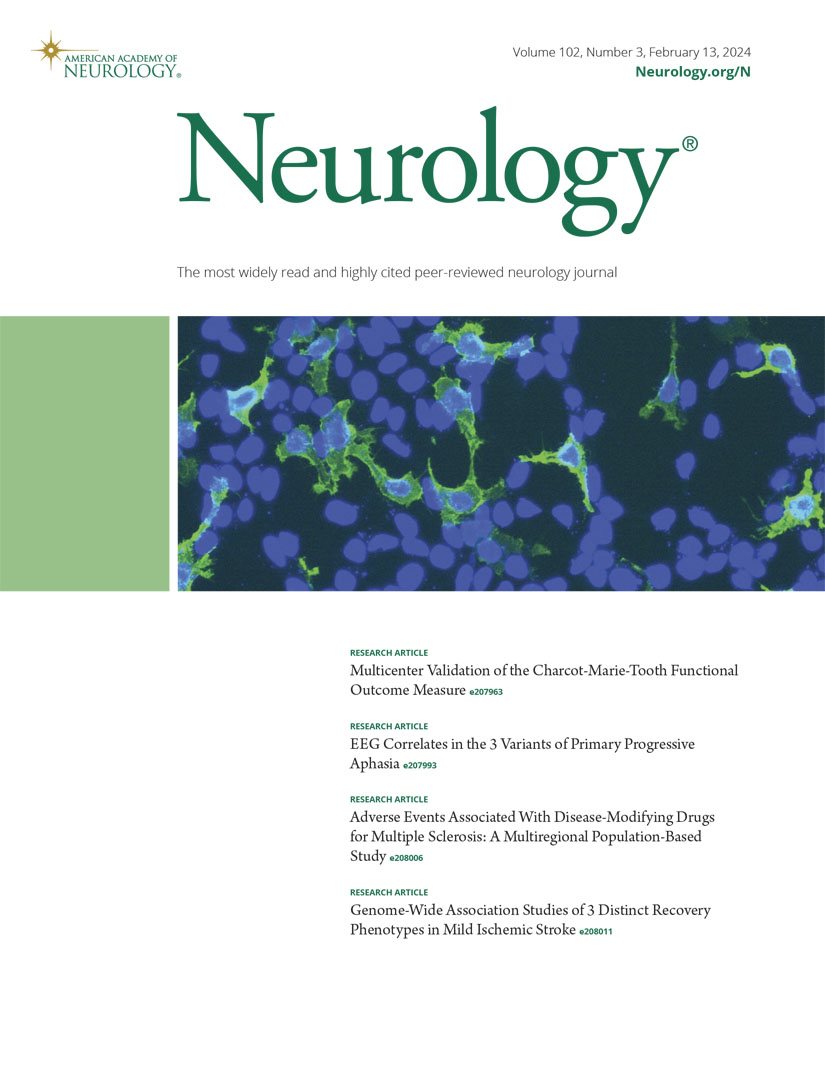Cross-Sectional and Longitudinal Associations of Neighborhood Disadvantage With Fluid Biomarkers of Neuroinflammation and Neurodegeneration.
IF 8.5
1区 医学
Q1 CLINICAL NEUROLOGY
引用次数: 0
Abstract
BACKGROUND AND OBJECTIVES Living in a socioeconomically disadvantaged neighborhood has an adverse impact on health outcomes, including increased risk of Alzheimer disease (AD). The biological mechanisms underlying this risk are poorly understood. We sought to examine how neighborhood disadvantage relates to core AD pathology, neurodegeneration, and inflammatory biomarkers in community-dwelling older adults cross-sectionally and over time. METHODS Participants included older adults from the Vanderbilt Memory and Aging Project who underwent fasting blood and CSF acquisition serially over a 9-year follow-up period (mean follow-up = 6.4 years [blood] and 4.0 years [CSF]). Area Deprivation Index (ADI), representing neighborhood disadvantage, was quantified at baseline using 17 components (e.g., housing, income, education, and household characteristics), with higher values indicating greater disadvantage. Ordinary least-squares regressions cross-sectionally related ADI to plasma and CSF inflammatory biomarkers adjusting for age, sex, race/ethnicity, education, modified Framingham Stroke Risk Profile score, APOE ε4 status, and cognitive status. Linear mixed-effects regression models related ADI to longitudinal biomarkers with identical covariates plus follow-up time. Outcomes included CSF chitinase-3-like protein 1 (YKL-40), CSF soluble-triggering receptor expressed on myeloid cells 2, CSF amyloid-β42 (Aβ42), CSF Aβ40/Aβ42 ratio, CSF tau, CSF phosphorylated tau (ptau), plasma high-sensitivity C-reactive protein (CRP), and plasma and CSF neurofilament light chain. RESULTS Participants (n = 334; 73 ± 8 years old, 59% male, 86% White, non-Hispanic) on average were from relatively less disadvantaged neighborhoods (ADI national decile = 33 ± 25, range = 1-98). Greater neighborhood disadvantage at study entry was cross-sectionally associated with elevated CSF YKL-40 (β = 0.7, p = 0.003) and tau (β = 1.8, p = 0.04) after excluding outliers. Greater neighborhood disadvantage at study entry related to faster longitudinal increases in plasma CRP (β = 0.005, p = 0.03). DISCUSSION Greater neighborhood disadvantage was associated with elevated inflammatory and AD CSF biomarkers cross-sectionally and longitudinal increases in a nonspecific inflammatory blood biomarker. Findings suggest that neighborhood disadvantage confers risk of systemic inflammation and AD pathology, providing a possible sociobiological mechanism underlying health disparities in aging adults; however, results were limited by use of ADI at study entry.邻域不利与神经炎症和神经退行性变液体生物标志物的横断面和纵向关联
背景和目的生活在社会经济条件较差的社区对健康结果有不利影响,包括阿尔茨海默病(AD)的风险增加。这种风险背后的生物学机制尚不清楚。我们试图通过横断面和时间研究社区居住老年人的社区劣势与核心AD病理、神经变性和炎症生物标志物之间的关系。方法参与者包括来自Vanderbilt记忆与衰老项目的老年人,他们在9年的随访期间(平均随访= 6.4年[血液]和4.0年[CSF])连续接受空腹血液和脑脊液采集。代表社区劣势的区域剥夺指数(ADI)在基线上使用17个组成部分(如住房、收入、教育和家庭特征)进行量化,数值越高表明劣势越大。普通最小二乘回归与血浆和脑脊液炎症生物标志物的横断面相关,调整了年龄、性别、种族/民族、教育、修正Framingham卒中风险概况评分、APOE ε4状态和认知状态。线性混合效应回归模型将ADI与具有相同协变量的纵向生物标志物加上随访时间相关。结果包括脑脊液几丁质酶-3样蛋白1 (YKL-40)、髓细胞上表达的脑脊液可溶性触发受体2、脑脊液淀粉样蛋白-β42 (Aβ42)、脑脊液Aβ40/Aβ42比值、脑脊液tau蛋白、脑脊液磷酸化tau蛋白(ptau)、血浆高敏c反应蛋白(CRP)、血浆和脑脊液神经丝轻链。结果受试者(n = 334;年龄73±8岁,59%为男性,86%为白人,非西班牙裔),平均来自相对较不贫困的社区(ADI国家十分位数= 33±25,范围= 1-98)。排除异常值后,研究开始时较大的社区劣势与CSF YKL-40 (β = 0.7, p = 0.003)和tau (β = 1.8, p = 0.04)升高横断面相关。研究开始时更大的社区劣势与血浆CRP纵向上升更快相关(β = 0.005, p = 0.03)。更大的社区劣势与炎症和AD CSF生物标志物的横断面升高和非特异性炎症血液生物标志物的纵向升高有关。研究结果表明,社区劣势增加了全身性炎症和AD病理的风险,为老年人健康差异提供了可能的社会生物学机制;然而,在研究开始时使用ADI限制了结果。
本文章由计算机程序翻译,如有差异,请以英文原文为准。
求助全文
约1分钟内获得全文
求助全文
来源期刊

Neurology
医学-临床神经学
CiteScore
12.20
自引率
4.00%
发文量
1973
审稿时长
2-3 weeks
期刊介绍:
Neurology, the official journal of the American Academy of Neurology, aspires to be the premier peer-reviewed journal for clinical neurology research. Its mission is to publish exceptional peer-reviewed original research articles, editorials, and reviews to improve patient care, education, clinical research, and professionalism in neurology.
As the leading clinical neurology journal worldwide, Neurology targets physicians specializing in nervous system diseases and conditions. It aims to advance the field by presenting new basic and clinical research that influences neurological practice. The journal is a leading source of cutting-edge, peer-reviewed information for the neurology community worldwide. Editorial content includes Research, Clinical/Scientific Notes, Views, Historical Neurology, NeuroImages, Humanities, Letters, and position papers from the American Academy of Neurology. The online version is considered the definitive version, encompassing all available content.
Neurology is indexed in prestigious databases such as MEDLINE/PubMed, Embase, Scopus, Biological Abstracts®, PsycINFO®, Current Contents®, Web of Science®, CrossRef, and Google Scholar.
 求助内容:
求助内容: 应助结果提醒方式:
应助结果提醒方式:


